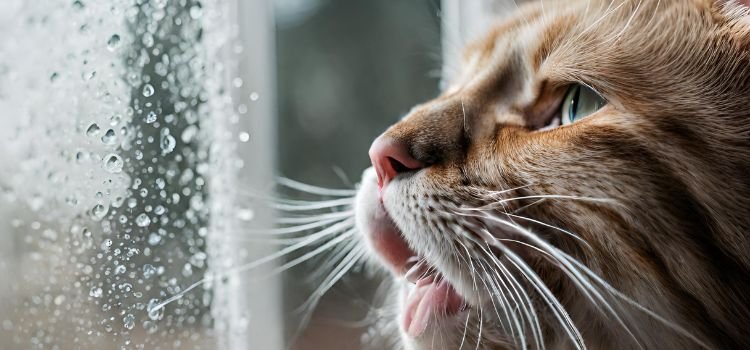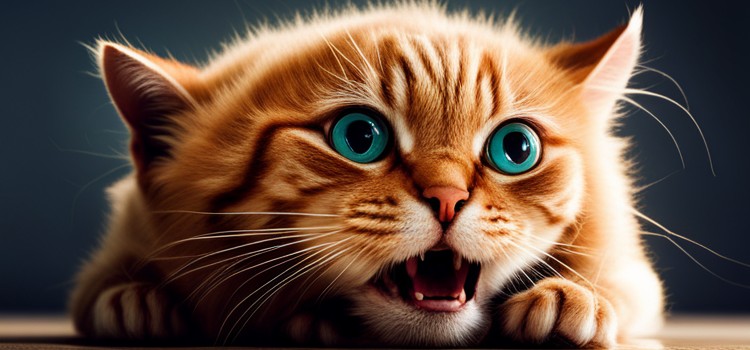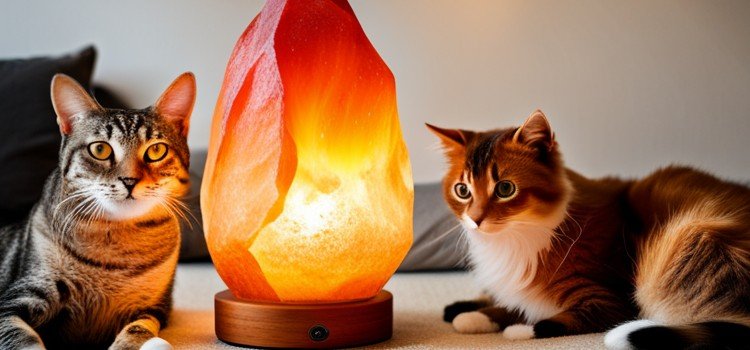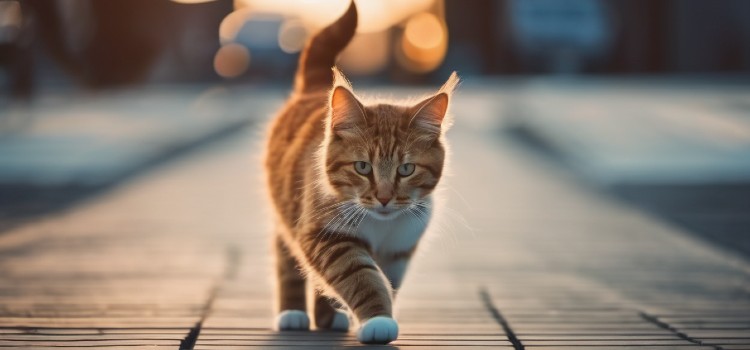As an Amazon Associate committed to the mission of improving the lives of our readers, Live-Clear.com receives a small commission from eligible purchases made through our affiliate links. This revenue enables us to keep producing insightful articles and other material.
Cats lick condensation because it tastes like water. When the surface temperature of an object is colder than the surrounding air, such as a cold glass of water or a can of soda, it causes moisture in the air to condense and form droplets on the surface.
This water droplet is what your cat is interested in, licking it to quench its thirst. Some cats may also enjoy the texture of the droplets or the sound they make when being licked. However, if your cat excessively licks condensation, it could be a sign of dehydration, and you should make sure it has access to plenty of fresh water.

Overall, the phenomenon of a cat licking condensation is normal and nothing to be concerned about, as it is a natural behavior for them to exhibit.
Feline Drinking Behaviors
When it comes to feline drinking behaviors, cats can exhibit some quirky habits that their humans may find baffling. One such behavior is when a cat licks condensation from a surface, particularly visible on a glass or a bottle. This can come as a surprise to many cat owners who wonder why their cat is doing this. In this blog post, we’ll explore the reasons behind this peculiar behavior and what it tells us about our feline friends.
Lapping Behavior
Before we delve into the licking behavior of cats, it’s important to understand how they drink water. Unlike humans, who create suction with their lips and suck in water, cats use a lapping action. Essentially, their tongue extends downwards, and they use the tip of their tongue to touch the water surface and lap the water up, as it creates a column due to the speed of the tongue movement.
Licking And Sucking Behaviors
Cats have unique senses of taste and smell, which can explain their desire to lick condensation. They may taste something that they find appealing, or they may detect a scent that draws them to the condensation. Additionally, some cats may have a tendency towards oral fixation, which makes them want to lick or suck on items, including condensation on surfaces. This behavior is not necessarily concerning unless it becomes obsessive and interferes with their daily routine.
In conclusion, while it may seem strange to see your cat licking condensation from a surface, it is generally harmless behavior. However, if you notice your cat having any other changes in drinking or eating habits, it’s important to consult with a veterinarian. Understanding your cat’s unique behavior can help deepen your bond with them and make you appreciate their quirks even more.
Understanding Cat Behavior
As cat owners, we all love our feline friends, but sometimes their behavior can be confusing. One common behavior that many cat owners wonder about is why their cats lick condensation. While it may seem like an unusual habit, it is actually quite normal and can be explained by understanding cat behavior.
What Is Normal Behavior?
While every cat is unique and may display different behaviors, certain patterns of behavior are considered normal for the species. Licking is one such behavior. Cats use their tongues to groom themselves and clean their fur. Additionally, they may lick objects or surfaces for various reasons, such as to taste or explore new scents.
How Do Cats Communicate?
Cats communicate not only through vocalizations but also through body language. They use their sense of smell to communicate with other cats and may lick surfaces to taste and better understand their environment. By licking condensation, your cat may be trying to gather information about the room or simply exploring a new sensation.
The Roles Of Smell And Taste
A cat’s sense of smell and taste are closely linked, allowing them to experience and understand their environment in different ways. By licking condensation, your cat may be exploring new scents or trying to determine if the surface is safe to touch or consume.
Understanding cat behavior can help us better care for our furry friends. Next time you see your cat licking condensation, remember that it is a normal behavior that is part of their natural curiosity and exploration of their environment.

What Is Condensation?
Condensation is the process of water droplets forming on a surface that is cooler than the surrounding air. Many cats enjoy licking condensation because it provides them with a source of water, especially in hot and dry environments.
The Science Of Condensation
Condensation is the process by which water vapor becomes liquid. This occurs as a result of a decrease in temperature and an increase in pressure. When warm air collides with a cold surface, such as glass, the air is cooled, and the water vapor in it turns into a liquid. This causes small water droplets to form on the surface, which we call condensation. When we look at a glass with condensation on it, we might wonder what causes this phenomenon.
As we mentioned earlier, when warm air touches the cool glass, the air molecules lose energy, move closer together, and form droplets of water on the surface. This is why we see the formation of water droplets on our cold glasses on a humid day.
Where Does It Form?
Condensation can occur on any surface that has a temperature lower than the dew point of the surrounding air. This means that any surface can have condensation, including windows, mirrors, and even floors and walls. However, it is most common on surfaces that have a large temperature difference from the surrounding air. Now that we have some understanding of what condensation is and where it forms, we can begin to answer the question: Why does my cat lick condensation? Some theories suggest that cats may lick condensation for its reflective properties. Cats are naturally curious creatures and may be attracted to the water droplets on a glass surface. Additionally, cats may be drawn to the taste of condensation, as it is often high in minerals and other nutrients that they may crave.
Condensation is a natural phenomenon that occurs when warm air collides with a cool surface. We often observe condensation on glasses, mirrors, and windows. As for why cats lick condensation, it remains a mystery, but it may be due to curiosity or to the taste of the water droplets.
The Mystery Of Licking Condensation
The mystery of why cats lick condensation has puzzled cat owners for ages. Is it a sign of a health problem or just a quirk of feline behavior? While there is no definitive answer, there are several theories that may shed some light on this peculiar habit.
Hypothesis #1: Attracted To Taste And Minerals
One reason why cats may lick condensation is that they are attracted to the taste and minerals found in it. Water that has been left out for a while can become stagnant and host bacteria, but condensation that has formed on a glass or can is fresh and pure. As a result, cats may find it appealing and lick it as a source of hydration and nutrients.
Hypothesis #2: Mimicking Prey Behavior
Cats are natural hunters and may instinctually mimic the behavior of their prey by licking dewdrops or moisture off leaves and branches. The act of licking condensation may satisfy this predatory instinct and provide a sense of satisfaction that comes with a successful hunt.
Hypothesis #3: Seeking Hydration
Cats have a low thirst drive and may not drink enough water on their own. Licking condensation may be a way for cats to supplement their water intake and ensure they stay hydrated. This is especially true for indoor cats who may not have access to fresh water sources other than their water bowl.
While the mystery of why cats lick condensation remains unsolved, these theories provide some insight into this curious behavior. Regardless of the reason, it is generally harmless and does not indicate any health problems. However, if you notice excessive licking or any other unusual behaviors in your cat, it is always best to consult with your veterinarian to rule out any underlying issues.

Factors That Influence Feline Drinking Behavior
Cats’ drinking behavior can be influenced by various factors, including the taste of the water, the location of the bowl, and their overall health. Drinking condensation from glasses, on the other hand, could indicate a form of play or a response to a variety of medical issues.
Cats are fascinating creatures, and their behavior can be both mysterious and intriguing. One of the common questions that cat owners have is regarding their pet’s drinking behavior. Why does a cat lick condensation or prefer to drink from certain sources and not others? There are several factors that influence feline drinking behavior, and we will explore them in this section.
The Importance Of Water
Water is vital for all creatures, and cats are no exception. According to the National Research Council of the National Academies, a healthy cat should consume approximately 4.5 ounces of water per 5 pounds of body weight. However, cats can be finicky when it comes to water, and their preferences can change with age, health, and even the weather. Therefore, ensuring that your cat has access to clean and fresh water at all times is crucial.
Relationship Between Food And Drinking Behavior
What a cat eats can also influence its drinking behavior. Cats that consume dry food may require more water than those that eat wet food. Dry food has a lower moisture content and can lead to dehydration if not adequately compensated with water. In contrast, wet food contains more water and often satisfies cats’ thirst. Therefore, if your cat is primarily eating dry food, provide it with enough water to compensate for the lack of moisture in the food.
Environmental Factors
Lastly, various environmental factors can affect feline drinking behavior. For instance, cats may prefer to drink from a running water source rather than a still one. This behavior is likely because running water is perceived as clean and fresh compared to stagnant water. Cats may also show a preference for drinking from a shallow bowl rather than a deep one. This behavior can be attributed to cats’ natural instincts as shallow water sources are typically safer for hunting and drinking.
Understanding the factors that influence feline drinking behavior is crucial for cat owners to ensure their pets remain hydrated and healthy. By providing clean, fresh water, considering your cat’s diet, and taking into account environmental factors, you can encourage your cat to drink more water and stay healthy.
Observing Your Cat’s Drinking Behaviors
Observing your cat’s drinking behaviors can help you understand their preferences and needs. If you notice your cat licking condensation, it’s because they are attracted to the cool temperature and fresh taste. Make sure your cat always has access to clean water to keep them healthy and hydrated.
Cats are fascinating creatures, and as a cat owner, you may find yourself watching your feline friend closely. Cats can display a range of quirky and unexpected behaviors, and one such behavior is licking condensation. This peculiar act can leave any cat owner baffled, but it is a common occurrence amongst our feline friends. If you want to understand why your cat licks condensation, start by observing your cat’s drinking behaviors.
Keeping A Journal
Recording your cat’s drinking behaviors in a journal can help you understand their habits. Include details like the frequency of water consumption, the type of water bowl, and the amount of water consumed. Jotting down this information over a period of time can provide insight into your cat’s drinking habits and preferences.
Noticing Subtle Cues
As you observe your cat’s drinking behaviors, pay attention to subtle cues. These can include the way your cat approaches their water bowl, how long they drink for, and what they do after drinking. If your cat prefers drinking from the faucet rather than their water bowl, it may be an indication that they prefer running water. Noticing these subtle cues can help you identify your cat’s drinking preferences.
| Drinking Behaviors | Cues |
|---|---|
| Frequency of water consumption | How often the cat visits water bowl |
| Type of water bowl | Preference for running water or still water |
| Amount of water consumed | How long the cat drinks for |
Closely observing your cat’s drinking behaviors can provide insight into their preferences and habits. Keeping a journal and paying attention to subtle cues are effective ways to understand your cat’s drinking behaviors. By doing so, you may be able to provide your feline friend with the ideal conditions for staying hydrated.

Supporting Your Cat’s Health
Supporting your cat’s health is essential to ensure that your feline companion stays happy and healthy. As a responsible pet owner, you must observe your cat’s behavior and identify any unusual habits. For instance, have you ever wondered why your cat licks condensation? In this post, we will discuss why your cat does so and provide tips on how you can keep your furry friend healthy.
Providing Fresh Water
Cats prefer to drink fresh water, so you should ensure that they always have access to clean water. Experts recommend that you change your cat’s water bowl daily. If your cat refuses to drink from their water bowl, you can try changing the location of the bowl or try using a different bowl.
Choosing The Right Bowl
The type of bowl you use to serve your cat’s water can also affect their drinking habit. Cats are sensitive to taste and smell, and a dirty bowl can put them off their water. It is recommended that you use a ceramic bowl or stainless steel bowl as they are easy to maintain. Avoid using plastic bowls since they can harbor bacteria, leading to feline acne or bacterial infections.
Encouraging Drinking
If your cat is not drinking enough water, you may need to encourage them to drink. You can add a little flavor to their water by pouring a little chicken or beef broth. Alternatively, you can also try feeding them wet food since most wet food has higher water content than dry food.
Now that you know why your cat licks condensation, you should provide fresh water regularly, choose the right bowl, and encourage drinking. These tips will ensure that your cat stays hydrated and healthy.
When Licking Condensation Is Abnormal
Have you ever noticed your kitty licking condensation on a cold glass or window? It’s actually a common behavior among cats! Licking condensation can help cats quench their thirst, but it can also be a form of entertainment for them.
Indications Of Medical Problems
In some instances, however, excessive licking of condensation can be a sign of an underlying health issue. If you notice your cat is obsessively licking objects that are not typically associated with condensation, it could be a sign that they are experiencing pica, a condition that causes the urge to eat non-food items.
It could also be a sign of dental issues, as cats may lick objects when experiencing pain in their mouths. If you find that your cat is excessively licking condensation along with other concerning behaviors, there could be an underlying health problem present.
When To Consult A Veterinarian
If you suspect there is an underlying health issue causing your cat’s excessive licking of condensation, it’s essential to seek a veterinarian’s advice. Some of the signs that you should take your cat to a vet include:
| Signs to Take Your Cat to the Vet |
|---|
| Licking condensation excessively along with other concerning behaviors |
| Difficulty in eating or drinking |
| Vomiting or diarrhea |
| Changes in appetite or weight |
It’s important to note that licking condensation, in and of itself, is not necessarily a cause for concern. It’s essential to look out for any changes in patterns, such as excessive licking and other concerning behaviors, as these could be a sign that there is a medical problem present.
If your cat is licking condensation excessively or showing any of the concerning behaviors mentioned above, be sure to seek a veterinarian’s advice to ensure the health and well-being of your furry friend.

Conclusion
Cats are peculiar creatures and their bizarre behavior often leaves us scratching our heads. Licking condensation may seem unusual, but it’s perfectly normal for cats. They are instinctively attracted to the scent of water and find it refreshing. However, if you notice excessive licking, it could be a sign of an underlying health issue.
Frequently Asked Questions Of Why Does My Cat Lick Condensation
Cats are curious creatures, and sometimes they like to lick or play with objects that intrigue them. Your cat may be attracted to the condensation on your cold water bottle, or they may enjoy the texture or taste of the bottle itself.
Cats like to lick cold things because it helps regulate their body temperature and provides sensory stimulation. Additionally, the coolness can help soothe any inflammation or discomfort in their mouth. It’s a natural behavior that should not be discouraged, but ensure that they have access to fresh water.
It’s not recommended for your cat to lick your sweat. Sweat can contain salt and other elements that may be harmful to your cat if consumed in large amounts. It’s best to avoid allowing your cat to lick any bodily fluids, including sweat, to keep them safe and healthy.
Cats may lick fleece because they enjoy its texture or taste. Additionally, licking may be a form of stress relief or a habit developed during grooming. As long as your cat doesn’t ingest too much fleece, it’s generally harmless.
Cats may lick condensation on windows because they’re thirsty or curious about water.
As responsible pet parents, we must monitor our cat’s behavior and seek veterinary help when necessary. Understanding their peculiar habits helps us provide better care for our furry feline friends.
Amazon and the Amazon logo are trademarks of Amazon.com, Inc, or its affiliates.



